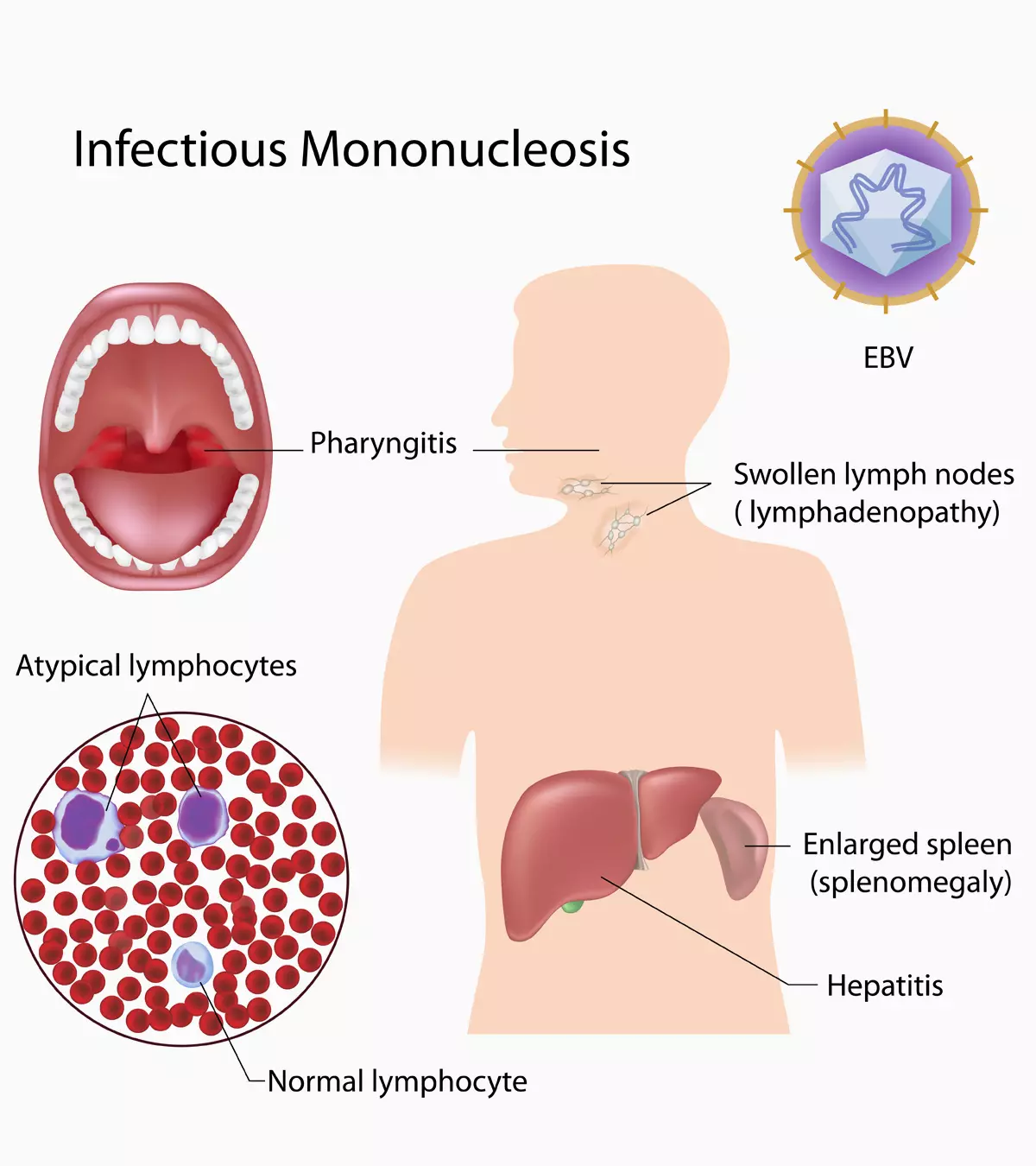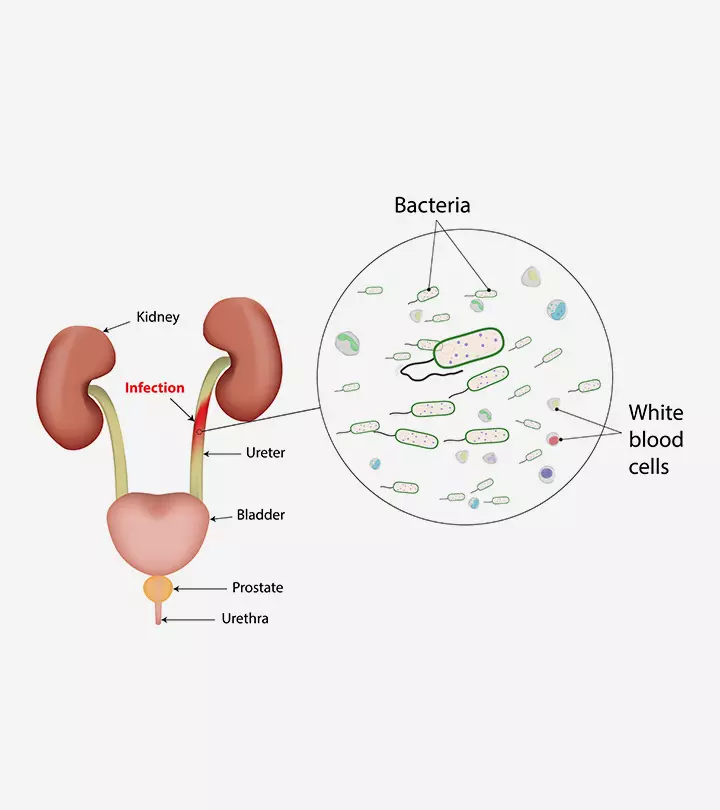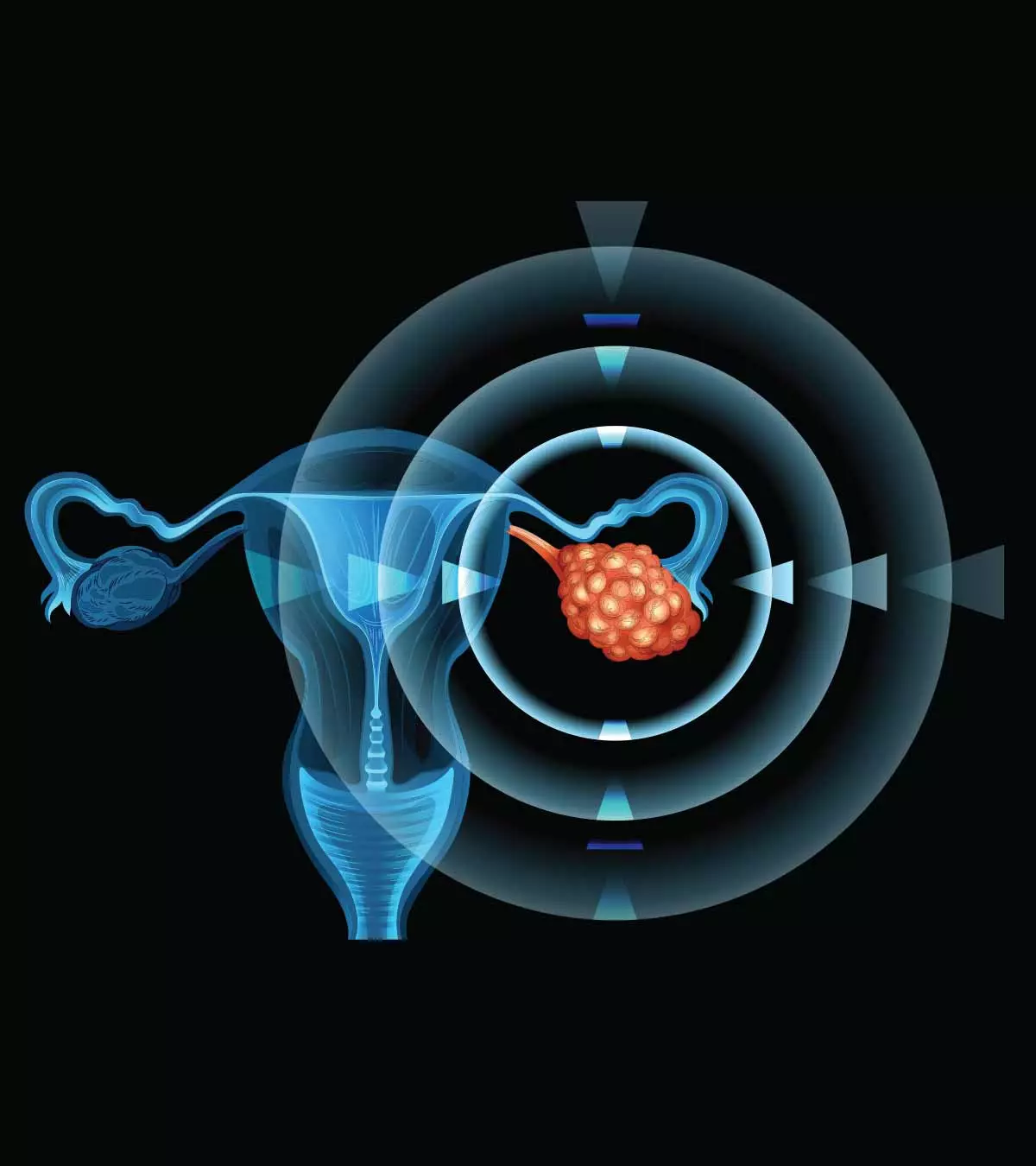
Image: Shutterstock
Ovarian cancer in teens is rare when compared to older women. Some may develop belly pain, urinary issues, and feeling full earlier while eating. However, most teens may not develop any symptoms, and it can be an accidental diagnosis. In addition, younger women and teens tend to have certain ovarian growths, such as germ cell tumors. Ovarian cancer may evolve in the ovaries or the distal end of fallopian tubes (1).
Ovaries are significant organs in the female reproductive system that produce oocytes or eggs and secrete estrogen and progesterone hormones. Cancerous growth in reproductive organs can be concerning, and one might worry about future fertility problems. According to the 2016-2020 statistics published by the National Cancer Institute, ovarian cancer cases were 10.3 per every 100,000 women annually. The estimated number of new cases in 2023 alone was 19,710.
Read on to know more about the causes, early symptoms, diagnosis, and treatment for ovarian cancer in teens.
Key Pointers
- Ovarian cancer in teens may not show any symptoms and the diagnosis can be accidental.
- Symptoms of ovarian cancer include abdominal fullness, urinary urgency, menstrual abnormalities, and unexplained weight loss.
- The diagnosis of ovarian cancer involves scans, X-rays, blood tests, colonoscopy, paracentesis and biopsies.
- Common treatments for ovarian cancer in teens are surgery, radiation, or chemotherapy.
- The cause of ovarian cancer in teens is unclear, but it may be related to genetic mutations or exposure to harmful substances.
Ovarian Cancer Symptoms And Signs In Teenager
Signs and symptoms of ovarian cancer may not be seen in many teens until the cancer is widespread. However, a few girls can have early cancer symptoms such as abdominal fullness and urinary urgency.
The following are the usual signs and symptoms of cancerous growth in the ovaries of a teen (2).
- Feeling full even after eating a small meal
- Eating difficulties and bloating
- Abdominal pain in teens
- Pelvic pain

Image: Shutterstock
- Back pain
- Urinary urgency — the constant urge to urinate
- Urinary frequency — urinating more than normal
- Extreme fatigue
- Stomach upset and constipation
- Dyspareunia — pain during sexual intercourse
- Abnormal and irregular vaginal bleeding
- Changes in menstruation
- Swelling of the abdomen
- Unexplained weight loss
These symptoms may be seen in both benign and cancerous growths of the ovary. Ovarian cancer may cause severe and persistent symptoms. Other illnesses and hormonal changes may also cause these symptoms in teens. Therefore, seek medical attention for the diagnosis of the underlying condition.
 Point to consider
Point to considerWhen To See A Doctor
You may seek medical attention in the following circumstances:
- If the symptoms are persistent or recurrent. Early cancer symptoms are usually the feelings of fullness, bloating, and urinary urgency.
- There is weight loss in your teen, without any apparent reason.
- Your girl has menstrual abnormalities such as irregular periods or missed periods.

Image: Shutterstock
Early diagnosis and intervention can improve the outcome.
Diagnosing Ovarian Cancer In Teens
Fluid in the abdomen (ascites) due to cancer and enlarged ovaries can be identified during the physical exam by a doctor
. It may be followed by further exams and tests.
If your teen’s tests are positive, then the doctor may refer her to a gynecologic oncologist, pediatric oncologist, or surgeon who specializes in cancer diagnosis and treatment. Ovarian cancers and other gynecologic cancers of the female reproductive system are usually treated by these specialists.
Most diagnostic tests involve imaging to visualize left and right ovary, adjacent structures, and distal metastasis (spread of cancerous cells to other parts). These tests could help determine cancer spread and thus establish treatment modalities. The following tests are used to diagnose ovarian cancer (3).
- Ultrasound imaging: Ultrasonography can be the first method to inspect ovaries. It can help determine the solid growth from fluid-filled cysts as well as their size. After the ovarian ultrasound, your teen may have to undergo other procedures based on the ultrasound result.
- Computed tomography (CT) scans: It helps visualize larger tumors of the ovary and other abdominal and pelvic organs in a cross-sectional view. This is useful for identifying metastasis. The doctor may perform a CT guided needle biopsy of metastaticiA progressive stage of cancer leading to the spread of cancerous cells from one place of the body to another tumors.
- Magnetic resonance imaging (MRI) scan: This is an imaging modality without the use of radiation. MRI helps to visualize ovarian growths and other metastasis (tumor spread to other parts of the body). This method is useful in identifying metastatic tumors in the brain and spinal cord.

Image: Shutterstock
- Chest X-ray: Chest radiography can show any spread of tumor in the lungs and pleural effusion (fluid collection in the pleural cavity, around the lungs) due to ovarian cancer.
- Positron emission tomography (PET) scan: This is a nuclear functioning imaging test that helps observe the metabolism of the organs and tissues. This uses radioactive fluorodeoxyglucose, and the uptake of this glucose is observed on images. Rapidly growing cancer cells absorb more glucose than normal cells. PET scan also helps to identify metastatic tumors.
- Laparoscopy: This helps look at the abdominal and pelvic cavity with cameras, through a small incision. It can be done before planning major treatment procedures, especially if imaging does not provide a clear idea of metastasis.
- Biopsy: It is the extraction of a section of the ovarian tissue for external evaluation. It can help determine the need for future chemotherapy or radiation therapy to prevent metastasis in most cases. A biopsy can be performed during laparoscopy or using a CT-guided needle before the removal of cancer, if required.
- Paracentesis: This procedure involves the collection of ascitic fluidiUnusual accumulation of fluid in the abdomen associated with swelling in the abdominal cavity using an ultrasound-guided needle. Analysis of this fluid helps identify the presence of cancer cells.
- Barium enema: It is a type of X-ray imaging of the gastrointestinal tract followed by the swallowing of barium by the patient. This could help identify rectal and colon metastasis. However, these days, colonoscopy is the preferred exam for this purpose.
- Colonoscopy: This technique is used to look for rectal and colon cancers, and the biopsy of suspicious lesions is obtained during the procedure.
- Blood test: This includes complete blood count, liver function, and kidney function analysis. Cancer antigen 125 (CA 125) is a protein that is usually found in ovarian cancers and is also measured. Alpha-fetoproteiniA protein present in the human fetus, used as a marker to study fetal abnormalities and certain tumors (AFP), lactate dehydrogenase (LDH), and human chorionic gonadotropiniA hormone typically produced during pregnancy but found to be elevated in certain cancers (HCG) levels are often elevated in germ cell cancers of the ovary. Blood tests may also help to determine ovarian hormone levels, which are useful in determining stromal cancers.
Genetic counseling and testing
can also be recommended by your teen’s doctor if there is any possibility of inherited gene mutations contributing to the development of ovarian cancer. Gene mutations such as breast cancer gene BRCA 1, or BRCA 2, MSH 2, PMS6, etc. can be identified on genetic testing.
Some molecular tests on cancer cells can also be done before choosing targeted immunotherapyiTreatment modality (most notably for cancer) that employs the body’s immune system to fight diseases to know its effectiveness. It is important to seek the opinion of a genetic counselor before genetic testing.
Overall, ovarian cancer rates tend to be low among teens. According to data from CDC, the rate of ovarian cancer among teens up to 14 years is less than one per 100,000 women. The rate goes up to 1.2 per 100,000 women for teens from 15 to 19 years.

Rate of ovarian cancer by age group
Source: Leading Cancers by Age, Sex, Race and Ethnicity; CDCStages Of Ovarian Cancer In Teens
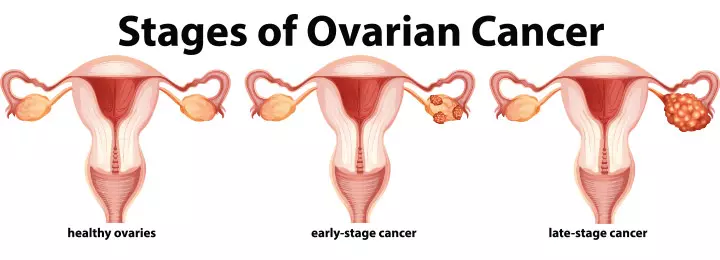
Image: Shutterstock
The cancer stage determines the extent of the spread of cancer. The staging can help decide treatment methods and determine the survival rate.
Stages of ovarian cancers range from stage I to IV. The higher the cancer stage, the more extensive is the spread of cancer. The TNM staging system usually indicates the size of cancer, spread to nearby lymph nodes, and metastasis to far tissues and organs.
According to the International Federation of Gynecology and Obstetrics (FIGO), ovarian cancer can be staged into (4):
- Stage I: Cancer is in the ovary, not spread to a nearby organ or lymph nodes.
- Stage II: Cancer is in one or both ovaries and spread to nearby organs or tissues such as the uterus, fallopian tubes, etc.
- Stage III: Cancer is in or both the ovaries and has spread to the abdomen or to the lymph nodes behind the abdomen.
- Stage IV: This is an advanced stage involving metastasis to organs or tissues far from the ovaries. Cancers of the liver, spleen, and lungs are often seen in this stage due to metastasis.
You may discuss with your teen’s doctor to know the stages, substages, and the required treatment and outcome of ovarian cancer in teenage groups.
Types Of Ovarian Cancer In Teens
Ovarian tumors can be of three different types as ovaries are made of three types of cells. Most ovarian mass can be benign, which are noncancerous growths or tumors. However, some primary ovarian tumors can be malignant tumors (cancerous) or low malignant (borderline) that may metastasize (spread) to other parts of the body.
The types of ovarian tumors are (5) (6):
1. Epithelial tumors
These are tumors beginning from the outer layer of the ovary and the most common type of ovarian tumor. Epithelial tumors can be benign or malignant (cancer).
- Serous or mucinous cystadenomas and Brenners tumors are benign epithelial tumors of the ovary.
- Atypical proliferative serous carcinoma or atypical proliferative mucinous carcinoma are examples of low malignant borderline ovarian tumors.
- Serous carcinomas are a common type of malignant tumor of the ovary.
Primary peritoneal carcinoma (PPC) and fallopian tubeiTube-like structures connecting the ovaries and uterus that help transport eggs for the fertilization process carcinoma are rare forms of cancers that can be similar to epithelial ovarian cancers
. These cancers can be treated similarly like ovarian cancers, and the outcome can be better compared to ovarian cancer (6).
2. Germ cell tumors
These affect the cells producing the oocyte (egg). The types of germ cell cancers that are common among teens are (6):
- Teratoma (dermoid cyst): Ovarian teratomas are benign germ cell tumors, and the immature germ cell tumors are cancerous. Immature teratomas may affect girls and young women, especially before the age of 18 years.
- Dysgerminoma: It is the most common ovarian cancer affecting teens and women in their twenties. These may grow slowly and can be cured by surgical removal in most young people. A small percentage of young people may require chemotherapy or radiation therapy to cure cancer.
- Yolk sac tumor or endodermal sinus tumor: These tumors are common in teenage women and often grow quickly. This can be managed with chemotherapy.
- Choriocarcinoma: This is very malignant germ cell carcinoma and associated with the presence of cancerous trophoblastic cells that are normally seen in embryos. These cancers also produce pregnancy hormone hCG in the absence of teen pregnancy.
3. Sex cord-stromal tumors
These are tumors of the structural tissues of the ovary and secrete hormones such as estrogeniA hormone responsible for the development and functioning of female reproductive organs and progesteroneiA female reproductive hormone that plays a vital role in menstruation, pregnancy, and breastfeeding . Ovarian stromal cancers are less common among teenage groups. This may often be associated with abnormal vaginal bleeding due to the secretion of hormones.
Breast development and menstruation in young girls before puberty can be due to sex cord-stromal cancers. This can be a cause of precocious puberty in young girls (7).
4. Small cell carcinoma (SCCO)
This is a rare form of ovarian cancer, and the type of cancer cells are not well identified, whether it is epithelial cells, germ cells, or stromal cells.
Some of the ovarian cysts — fluid collection inside the ovary — can be cancerous. However, most can be normal due to the ovulation process and called functional cysts. Normal ovarian benign cysts may disappear in a few months without any interventions, whereas the malignant once can be persistent and require surgical removal (6).
 Experts say
Experts sayTreating Ovarian Cancer In Teens
Your teen’s doctor may suggest treatment options weighing the benefits and risks along with the stage of cancer. Most may undergo surgical recession of cancer and radiation or chemotherapy before or after surgery based on the type and spread of cancer.
Generally, ovarian cancers are managed with local and systemic treatments. Local treatments do not affect the rest of the body and include the following (8) (9).
- Surgical excision or removal of ovarian cancer.
- Radiation therapy may often be used for distant or near-metastatic tumors from ovarian cancer.
Systemic therapies
involve the treatment of cancer with drugs for optimum effect on malignant cells anywhere in the body. These chemotherapy drugs can be taken orally or intravenously.
The following are types of systemic therapies for ovarian cancer (8) (9).
- Chemotherapy: It is a treatment using drugs such as taxane, cisplatin, etc., and can be given intraperitoneally (injected directly into the abdominal cavity).
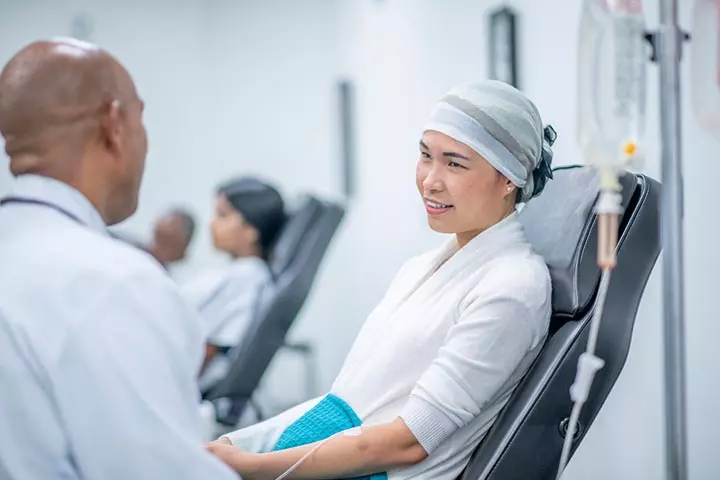
Image: IStock
- Hormone therapy: It involves treatment with hormones and hormone inhibiting drugs. This method is useful in treating stromal cancers of the ovaries that cause the secretion of ovarian hormones.
- Targeted therapy: The drug therapy use specific drugs or substances that may damage only cancer cells and spare normal cells from damage. Bevacizumab or Avastin is a drug that could target abnormal cells of the affected ovary.
Some young women can be fully cured of ovarian cancer after the removal and therapies. However, many may have metastasis or recurrence and require chemotherapy drugs for a longer duration. The chance of cure may vary in each teen based on the cancer type and stage. Therefore, you should discuss your teen’s case with a specialist.
Causes Of Teen Ovarian Cancer
The exact cause of ovarian cancer is yet to be identified. A few risk factors may make a girl susceptible to epithelial ovarian cancers. The causative factors for other kinds of ovarian cancers are less understood. The following are a couple of likely causative factors for ovarian cancer in teens.
1. Genetics
Genetic mutations or changes in the genes that are part of DNA may be associated with ovarian cancer. Gene mutations might result in cancer-causing syndromes that could run in families. A few examples of such syndromes are PTEN hamartoma tumor, Peutz-Jeghers, and hereditary nonpolyposis syndrome.
If there is a history of cancers linked to these syndromes in your family, then seek healthcare provider’s advice for your teen.
2. Radiation or cancer-causing chemicals
Exposure to radiation and carcinogenic chemicals may lead to gene mutation. Sometimes, ovarian cancers can be a result of multiple acquired genetic mutations. Although radiation and chemicals are often considered high-risk factors for ovarian cancer, more studies are required to identify the exact causes of ovarian cancers (10).
Prevention Of Ovarian Cancer In Teens
There is no known way to prevent ovarian cancer (11). The risk factors may only slightly increase the possibility of ovarian cancers. So avoiding risk factors may not always prevent cancer.
A few measures, such as early pregnancy, breastfeeding, etc., can be useful in preventing epithelial tumors, which are common in older women. However, the germ cell tumors that are common among teens may not be prevented by these methods.
If a teen has a history of cancer, then follow up care and tests after treatment may prevent a recurrence. Although the cancer is treated, these visits may be required for many years to identify any early signs of metastasis or recurrence (12).
Complications Of Ovarian Cancer In A Teenager
Complications of ovarian cancers can arise due to changes in hormone levels in functional ovarian cancers and the growing ovarian mass. Surgical removal of ovaries can also cause complications due to hormonal imbalance if hormone replacement therapy is not initiated. These complications may include (13):
- Mood changes
- Infertility
- Early menopause symptoms such as osteoporosisiA condition that weakens bones, increasing the risk of sudden, unsuspected bone fractures , vaginal dryness, and decreased sexual desires
Survivors may develop second cancers of the same or other tissues or organs in later life. The following second cancers are common among primary ovarian cancer survivors (14).
- Colon cancer
- Small intestine cancer
- Rectal cancer
- Renal (kidney) pelvis cancer
- Breast cancer
- Bladder cancer
- Bile duct cancer
- Acute leukemiaiLeukemia
- Ocular (eye) melanoma
- Soft tissue sarcoma
- Bone cancer (rare)
Regular follow-ups and the continuation of chemotherapy may help reduce the risk of secondary cancers.
The use of oral contraceptives and certain contraceptive devices may reduce the chance of ovarian cancer. Pregnancy till term and breastfeeding may also act as protective factors. However, teenage or adolescent pregnancy can have its risks and complications.
Ovarian Cancer Survival Rate In Teens
The survival rate is the percentage and time the people with the same cancer type and stage are alive after the diagnosis. This is useful in deciding treatment, and this may vary in each person.
The survival rates for cancer in teenagers can depend on various factors, such as their age and overall health status. However, due to recent advances in cancer treatments, ongoing research and clinical trials, the survival rates in teens with ovarian cancers might improve in the near future.
Frequently Asked Questions
1. What is the youngest age of a patient detected with ovarian cancer?
According to the data given by the Centers for Disease Control and Prevention, ovarian cancer is reported in girls as young as five (15). However, it is rare in children.
2. How common is ovarian cancer in teens?
Ovarian cancer is rare in teenagers, and ovarian tumors account for 1% of all cancers between birth and 17 years (16).
3. At what stage is ovarian cancer terminal?
Ovarian cancer that has progressed to stage 4 is often referred to as advanced. This means that cancer has spread to other organs and is likely to be terminal (19).
Ovarian cancer in teens often arises due to genetic factors. The illness proceeds in stages, and the treatment varies accordingly. In most cases, it is benign, and treatment is possible with awareness about the symptoms such as frequent urination, bloating, and fatigue. Ovarian cancer in teens can impact their lives physically and mentally, increasing the risk of complications such as infertility or early menopause. Hence timely diagnosis and treatment may help manage the condition. Remember to provide the teen with the utmost understanding and support for an effective healing process.
Infographic: Ovarian Cancer Symptoms In Teenagers
Although not very common, ovarian cancers in teens present one or more peculiar symptoms. Furthermore, the treatment and recovery process can accelerate when these signs are identified early. So, scour through this infographic to understand typical symptoms of ovarian cancer in teenagers. Illustration: Momjunction Design Team
Do not ignore these signs! Learn about the 5 hidden symptoms of ovarian cancer that you may not know about. Get the facts and stay informed.
Illustration: Symptoms Of Ovarian Cancer In Teens And Survival Rate

Image: Stable Diffusion/MomJunction Design Team
References
1. Types of Cancers That Develop in Adolescents;The American Cancer Society
2. Signs and Symptoms of Ovarian Cancer; The American Cancer Society
3. Ovarian Epithelial, Fallopian Tube, and Primary Peritoneal Cancer Treatment (PDQ®)–Patient Version; The National Cancer Institute; The National Institutes of Health (NIH)
4. Jaime Prat and FIGO Committee on Gynecologic Oncology; FIGO’s staging classification for cancer of the ovary, fallopian tube, and peritoneum: abridged republication; The United States National Library of Medicine
5. Ovarian Cancer Types and Stages; National Ovarian Cancer Coalition
6. What Is Ovarian Cancer?; The American Cancer Society
7. Mahin Hashemipour, et al.; Granulosa cell tumor in a six-year-old girl presented as precocious puberty; The United States National Library of Medicine
8. Treatment of ovarian cancer; The National Health Service
9. Treating Ovarian Cancer; The American Cancer Society
10. What Causes Ovarian Cancer?; The American Cancer Society
11. Reducing Risk for Ovarian Cancer; Centers for Disease Control and Prevention
12. After Treatment; The American Cancer Society
13. Ovarian, Fallopian Tube, and Primary Peritoneal Cancer Prevention (PDQ®)–Patient Version; The National Cancer Institute; The National Institutes of Health (NIH)
14. Second Cancers After Ovarian Cancer; The American Cancer Society
15. United States Cancer Statistics: Data Visualizations; The Centers for Disease Control and Prevention.
16. Childhood Ovarian Tumors; Dana-Farber Cancer Institute
17. Suk Hee Heo et al.; Review of Ovarian Tumors in Children and Adolescents: Radiologic-Pathologic Correlation; Pediatric Imaging
18. Childhood Ovarian Cancer Treatment (PDQ®)–Patient Version;
19. Michelle Lockley et al.; Ovarian cancer in adolescents and young adults; ANA Oncology: Review.
Community Experiences
Join the conversation and become a part of our nurturing community! Share your stories, experiences, and insights to connect with fellow parents.
Read full bio of Dr. Elna Gibson
Read full bio of Dr Bisny T. Joseph
Read full bio of Swati Patwal
Read full bio of Anindita Ghatak













